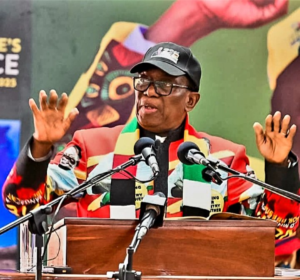THE INEVITABLE DECLINE OF ZANU PF: A STUDY IN COERCION AND FAILED POLITICAL STRATEGIES
In the complex and fraught political landscape of Zimbabwe, a paradox exists that is as irreconcilable as the nature of flying fish to gravity. On one hand, there are allegations of opposition members defecting to the ruling party, Zanu PF, dubbed by critics as an “evil incarnation on earth.” On the other, there are widespread reports of coercion, where civil servants, particularly teachers and nurses who stand at the lowest end of the remuneration totem pole, are forced into the folds of what many describe as a terrorist organization. This contradiction highlights a fundamental truth about the political dynamics in Zimbabwe: the existence of suffering and misery across the board, exacerbated by unconstitutional power retention and terror tactics employed by Zanu PF.
Gukurahundi, a term that evokes memories of one of the darkest chapters in Zimbabwe’s history, serves as a poignant reminder of the lengths to which Zanu PF has gone to secure its grip on power. This historical context strips away any veil of subjectivity, reinforcing the narrative that Zanu PF thrives on fear and oppression to maintain control.
Ironically, the rebranding of national television by Auxillia Mnangagwa, transitioning from what was once known as Grace Mugabe television, has not served as a platform to showcase the reality of coerced membership among civil servants. Instead, it continues the tradition of Zanu PF’s ego-stroking exercises, parading disenchanted individuals as defectors from the opposition. This glaring omission speaks volumes, serving as a stark reminder of the party’s reliance on manipulation and intimidation rather than genuine support from the populace.
The coercion of civil servants into Zanu PF membership is a testament to the party’s desperation. Rather than addressing the genuine grievances of these essential workers, Zanu PF chooses to wield coercion as a weapon. This approach not only alienates and marginalizes significant sections of the society but also highlights the regime’s failure to engage constructively with its citizens.
The preferential treatment of partisan security forces, through salary hikes in response to inflation, further exposes the inherent inequalities and the reliance on force to maintain order. This strategy, however, is shortsighted. Teachers and nurses, who have remained largely non-partisan, seek nothing more than fair remuneration that shields them from the harsh economic realities of Zimbabwe. Labeling them as saboteurs for demanding their economic rights only serves to deepen the divide between the government and its people.
The looming question then becomes: Can coercion and unspecified threats sustain Zanu PF’s hold on power? The answer is a resounding no. The changing mood among the electorate, coupled with the rise of opposition forces, signals a shift towards constitutionalism, rule of law, and the restoration of peace in Zimbabwe. The era of relying on a partisan military and coercive tactics is coming to an end, as the populace grows increasingly aware and resistant to such measures.
Moreover, the advent of social media has changed the game, breaking the monopoly on information once held by state-controlled media. The ability of opposition parties to communicate directly with their supporters, bypassing the need for police clearance, has introduced a new dynamic that Zanu PF is ill-prepared to counter.
In conclusion, Zanu PF’s reliance on outdated tactics of coercion, media repression, and preferential treatment of partisan forces is a strategy doomed to fail. Like the dinosaurs, the party risks extinction in the face of innovative opposition and a populace yearning for change. The inevitable decline of Zanu PF is not just a possibility but a certainty, as the winds of change sweep across Zimbabwe, heralding a new era of peace, democracy, and respect for human rights.




